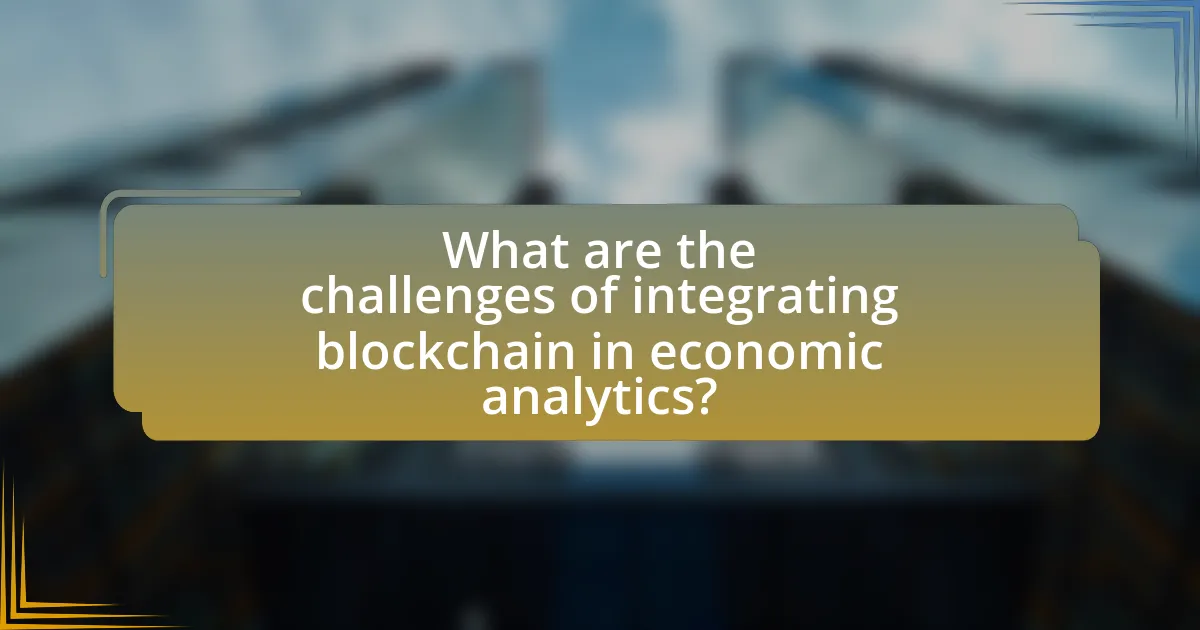Integrating blockchain technology in economic analytics involves the use of decentralized ledger systems to improve data transparency, security, and efficiency in economic data analysis. Key features of blockchain, such as immutability and decentralization, enhance data integrity and facilitate real-time tracking of transactions, which leads to more accurate economic forecasts. The article explores how blockchain addresses challenges in economic analytics, including data integrity and traceability, while also discussing its applications in financial forecasting and supply chain management. Additionally, it highlights the regulatory considerations and best practices for successful integration of blockchain in economic analytics.

What is Integrating Blockchain Technology in Economic Analytics?
Integrating blockchain technology in economic analytics involves utilizing decentralized ledger systems to enhance data transparency, security, and efficiency in economic data analysis. This integration allows for real-time tracking of transactions and economic indicators, which can improve the accuracy of economic forecasts and analyses. For instance, blockchain’s immutable records can reduce data manipulation risks, thereby providing more reliable datasets for economists and analysts. Additionally, studies have shown that blockchain can streamline processes such as supply chain management and financial transactions, leading to cost reductions and improved economic performance.
How does blockchain technology enhance economic analytics?
Blockchain technology enhances economic analytics by providing a decentralized and immutable ledger that ensures data integrity and transparency. This technology allows for real-time tracking of transactions and assets, enabling more accurate and timely economic data analysis. For instance, the use of blockchain in supply chain management allows businesses to trace the flow of goods and verify transactions, leading to improved forecasting and decision-making. Additionally, blockchain’s ability to facilitate smart contracts automates and streamlines processes, reducing the potential for human error and fraud. According to a report by the World Economic Forum, blockchain could contribute up to $1 trillion to the global economy by improving efficiency and reducing costs in various sectors, further validating its impact on economic analytics.
What are the key features of blockchain that benefit economic analytics?
The key features of blockchain that benefit economic analytics include transparency, immutability, and decentralization. Transparency allows all participants in a blockchain network to access the same data, which enhances trust and facilitates accurate economic analysis. Immutability ensures that once data is recorded on the blockchain, it cannot be altered or deleted, providing a reliable historical record for economic metrics. Decentralization eliminates the need for a central authority, reducing the risk of data manipulation and fostering a more equitable economic environment. These features collectively enhance the integrity and reliability of economic data, enabling more informed decision-making and analysis.
How does data transparency in blockchain impact economic analysis?
Data transparency in blockchain significantly enhances economic analysis by providing real-time access to accurate and immutable data. This transparency allows economists and analysts to track transactions, assess market behaviors, and evaluate economic trends with greater precision. For instance, a study by the World Economic Forum highlights that blockchain’s transparent nature can reduce information asymmetry, leading to more informed decision-making and efficient market operations. Additionally, the availability of verifiable data fosters trust among stakeholders, which is crucial for economic stability and growth.
Why is integrating blockchain important for economic analytics?
Integrating blockchain is important for economic analytics because it enhances data integrity and transparency. Blockchain technology provides a decentralized and immutable ledger, which ensures that economic data is accurate and tamper-proof. This reliability is crucial for analysts who rely on precise data to make informed decisions. For instance, a study by the World Economic Forum highlights that blockchain can reduce data discrepancies by up to 90%, thereby improving the quality of economic forecasts and analyses. Additionally, the real-time nature of blockchain allows for timely insights, enabling quicker responses to economic changes.
What challenges in economic analytics can blockchain address?
Blockchain can address challenges in economic analytics such as data integrity, transparency, and traceability. By providing a decentralized ledger, blockchain ensures that data is immutable and verifiable, reducing the risk of fraud and manipulation. For instance, a study by the World Economic Forum highlights that blockchain can enhance data accuracy and reliability, which are critical for effective economic analysis. Additionally, blockchain’s transparent nature allows stakeholders to access real-time data, facilitating better decision-making and accountability in economic transactions.
How does blockchain improve data security in economic analytics?
Blockchain enhances data security in economic analytics by providing a decentralized and immutable ledger for data storage. This technology ensures that once data is recorded, it cannot be altered or deleted without consensus from the network, thereby preventing unauthorized modifications. The cryptographic techniques used in blockchain, such as hashing and digital signatures, further protect data integrity and authenticity. For instance, a study by the World Economic Forum highlights that blockchain can reduce data breaches by up to 80% due to its secure architecture. This combination of decentralization, immutability, and cryptographic security makes blockchain a robust solution for safeguarding sensitive economic data.

What are the applications of blockchain in economic analytics?
Blockchain technology has several applications in economic analytics, primarily enhancing data integrity, transparency, and efficiency in economic data management. By providing a decentralized ledger, blockchain ensures that economic data is immutable and verifiable, which is crucial for accurate analytics. For instance, blockchain can be used to track and analyze supply chain data, enabling businesses to optimize operations and reduce costs through real-time insights. Additionally, blockchain facilitates secure and transparent transactions, allowing for better tracking of economic indicators such as inflation rates and GDP growth. Studies have shown that integrating blockchain in economic analytics can lead to improved decision-making processes and more reliable economic forecasts, as evidenced by projects like the World Bank’s use of blockchain for financial inclusion initiatives.
How is blockchain used in financial forecasting?
Blockchain is used in financial forecasting by providing a decentralized and transparent ledger that enhances data integrity and accessibility. This technology allows financial analysts to access real-time data from multiple sources, improving the accuracy of predictive models. For instance, blockchain can facilitate the collection of transaction data from various stakeholders, ensuring that the information is tamper-proof and reliable. A study by Deloitte highlights that the use of blockchain in financial services can reduce forecasting errors by up to 30% due to its ability to provide accurate and timely data.
What data sources are utilized in blockchain for economic forecasting?
Blockchain utilizes various data sources for economic forecasting, including transaction data, smart contract data, and off-chain data. Transaction data provides insights into market trends and consumer behavior by analyzing the volume and frequency of transactions recorded on the blockchain. Smart contract data reveals automated agreements and their execution, which can indicate economic activity and market confidence. Off-chain data, such as social media sentiment and economic indicators, can be integrated with blockchain data to enhance forecasting accuracy. These sources collectively enable more precise economic predictions by leveraging the transparency and immutability of blockchain technology.
How does blockchain improve the accuracy of financial predictions?
Blockchain improves the accuracy of financial predictions by providing a decentralized and immutable ledger that enhances data integrity and transparency. This technology allows for real-time access to verified financial data, reducing the risk of errors and fraud. For instance, a study by the World Economic Forum indicated that blockchain could reduce data reconciliation costs by up to 70%, thereby increasing the reliability of financial models. Additionally, the use of smart contracts on blockchain platforms automates transactions and ensures that data is consistently updated, further refining predictive analytics.
What role does blockchain play in supply chain economics?
Blockchain enhances supply chain economics by providing transparency, traceability, and efficiency. It allows all parties in the supply chain to access a single, immutable ledger, which reduces fraud and errors. For instance, a study by the World Economic Forum in 2020 highlighted that blockchain could reduce supply chain-related costs by up to 20% through improved data sharing and reduced reconciliation efforts. This technology also enables real-time tracking of goods, which optimizes inventory management and reduces waste, further contributing to economic efficiency.
How does blockchain enhance traceability in supply chains?
Blockchain enhances traceability in supply chains by providing a decentralized and immutable ledger that records every transaction and movement of goods. This technology allows all participants in the supply chain to access real-time data regarding the origin, status, and journey of products, ensuring transparency and accountability. For instance, a study by the World Economic Forum in 2020 highlighted that blockchain can reduce the time required to trace a product’s journey from weeks to seconds, significantly improving efficiency and trust among stakeholders.
What economic benefits arise from using blockchain in supply chain management?
The economic benefits of using blockchain in supply chain management include enhanced transparency, reduced costs, and improved efficiency. Blockchain technology allows for real-time tracking of goods, which minimizes discrepancies and fraud, leading to lower operational costs. According to a report by the World Economic Forum, blockchain can reduce supply chain-related costs by up to 20% through improved inventory management and reduced paperwork. Additionally, the decentralized nature of blockchain fosters trust among stakeholders, which can lead to better collaboration and faster decision-making processes.

What are the challenges of integrating blockchain in economic analytics?
The challenges of integrating blockchain in economic analytics include scalability, data privacy, regulatory compliance, and interoperability. Scalability issues arise because blockchain networks can struggle to process large volumes of transactions quickly, which is essential for real-time economic analysis. Data privacy concerns stem from the transparent nature of blockchain, where sensitive economic data may be exposed. Regulatory compliance is complicated by the evolving legal frameworks surrounding blockchain technology, which can vary significantly across jurisdictions. Lastly, interoperability challenges exist as different blockchain platforms may not easily communicate with one another, hindering the seamless integration of economic data across systems. These challenges must be addressed to effectively leverage blockchain for economic analytics.
What technical barriers exist in implementing blockchain for economic analytics?
Technical barriers in implementing blockchain for economic analytics include scalability issues, interoperability challenges, and data privacy concerns. Scalability is a significant barrier as many blockchain networks struggle to handle large volumes of transactions efficiently; for instance, Bitcoin processes approximately seven transactions per second, which is insufficient for high-frequency economic analytics. Interoperability poses another challenge, as different blockchain platforms often lack compatibility, making it difficult to integrate diverse data sources. Additionally, data privacy is a critical concern, as blockchain’s transparency can conflict with the need to protect sensitive economic data, leading to potential regulatory compliance issues. These barriers hinder the effective application of blockchain technology in economic analytics.
How can organizations overcome scalability issues with blockchain?
Organizations can overcome scalability issues with blockchain by implementing layer-2 solutions, such as state channels or sidechains, which allow transactions to be processed off the main blockchain while still benefiting from its security. For instance, the Lightning Network for Bitcoin enables faster transactions by creating off-chain payment channels, significantly increasing throughput. Additionally, adopting sharding techniques can distribute data across multiple nodes, enhancing processing capacity and reducing congestion. Research indicates that Ethereum’s transition to a proof-of-stake consensus mechanism aims to improve scalability by increasing transaction speed and reducing energy consumption, further validating the effectiveness of these approaches.
What are the interoperability challenges between blockchain and existing systems?
Interoperability challenges between blockchain and existing systems primarily stem from differences in data formats, protocols, and governance structures. Existing systems often utilize centralized databases and traditional data exchange protocols, while blockchain operates on decentralized, distributed ledgers that require consensus mechanisms. This fundamental difference complicates seamless data sharing and integration. For instance, the lack of standardized APIs and protocols across various blockchain platforms hinders communication with legacy systems, leading to inefficiencies and increased costs in integration efforts. Additionally, regulatory compliance and security concerns further complicate interoperability, as existing systems may not align with the decentralized nature of blockchain technology.
What regulatory considerations must be addressed?
Regulatory considerations that must be addressed when integrating blockchain technology in economic analytics include data privacy, compliance with financial regulations, and anti-money laundering (AML) requirements. Data privacy regulations, such as the General Data Protection Regulation (GDPR) in Europe, mandate that organizations ensure the protection of personal data, which can be challenging in a decentralized blockchain environment. Compliance with financial regulations, including the Securities and Exchange Commission (SEC) guidelines, is essential to avoid legal repercussions when dealing with digital assets. Additionally, adherence to AML regulations is critical to prevent illicit activities, as blockchain’s transparency can both aid and hinder compliance efforts. These considerations are vital for ensuring that blockchain applications in economic analytics operate within legal frameworks and maintain user trust.
How do data privacy laws affect blockchain integration in economic analytics?
Data privacy laws significantly impact blockchain integration in economic analytics by imposing restrictions on data collection, storage, and sharing practices. These laws, such as the General Data Protection Regulation (GDPR) in Europe, require organizations to ensure that personal data is processed lawfully, transparently, and for specific purposes. Consequently, blockchain’s inherent transparency and immutability can conflict with these requirements, as data recorded on a blockchain may not be easily altered or deleted, which is a key aspect of compliance with data privacy regulations. For instance, GDPR mandates the right to erasure, which challenges the permanence of blockchain records. Therefore, organizations must develop innovative solutions, such as using privacy-enhancing technologies or permissioned blockchains, to align blockchain applications with data privacy laws while still leveraging the benefits of blockchain in economic analytics.
What compliance issues should organizations be aware of when using blockchain?
Organizations using blockchain must be aware of compliance issues related to data privacy, regulatory frameworks, and anti-money laundering (AML) laws. Data privacy concerns arise from the immutable nature of blockchain, which can conflict with regulations like the General Data Protection Regulation (GDPR) that require the ability to delete personal data. Regulatory frameworks vary by jurisdiction, necessitating organizations to navigate complex legal landscapes that may include securities laws and consumer protection regulations. Additionally, AML laws require organizations to implement measures to prevent illicit activities, which can be challenging due to the pseudonymous nature of blockchain transactions. These compliance issues highlight the need for organizations to develop robust governance frameworks to ensure adherence to applicable laws and regulations.
What best practices should be followed for successful integration?
Successful integration of blockchain technology in economic analytics requires a clear strategy, stakeholder engagement, and robust data governance. Establishing a well-defined integration strategy ensures alignment with organizational goals and addresses specific use cases for blockchain. Engaging stakeholders, including technical teams, management, and end-users, fosters collaboration and ensures that the integration meets diverse needs. Implementing strong data governance practices, such as data quality management and compliance with regulations, enhances the reliability and security of the analytics derived from blockchain data. These practices are supported by industry reports indicating that organizations with clear strategies and stakeholder involvement achieve higher success rates in technology integration.
How can organizations ensure data quality when using blockchain in economic analytics?
Organizations can ensure data quality when using blockchain in economic analytics by implementing robust validation mechanisms and maintaining comprehensive data governance frameworks. These mechanisms include consensus algorithms that verify transactions before they are added to the blockchain, ensuring that only accurate and agreed-upon data is recorded. Additionally, organizations should establish clear protocols for data entry and management, including regular audits and updates to the blockchain to correct any discrepancies. Research indicates that blockchain’s inherent immutability and transparency can significantly enhance data integrity, as seen in studies highlighting its effectiveness in supply chain management, where accurate tracking of goods has been shown to reduce errors by up to 30%.
What strategies can enhance stakeholder collaboration in blockchain projects?
To enhance stakeholder collaboration in blockchain projects, implementing transparent communication channels is essential. This strategy fosters trust among stakeholders by ensuring that all parties have access to the same information, which is critical in decentralized environments. Research indicates that projects with clear communication frameworks experience 30% higher stakeholder satisfaction, as stakeholders feel more involved and informed about project developments. Additionally, utilizing collaborative tools such as shared digital platforms can streamline interactions and decision-making processes, further improving engagement and cooperation among stakeholders.


